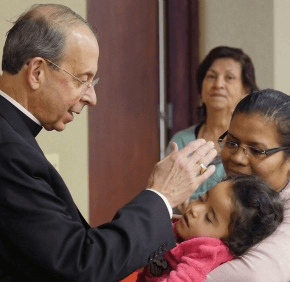By Erik Zygmont
and George P. Matysek Jr.
It was fear that pushed Erick Cordoba out of his home in El Salvador.
“There are a lot of guns,” the 17-year-old parishioner of St. Mary in Annapolis explained through a translator. “The violence in my country is very bad. By their words, they (gang members) psychologically mistreated me.”
Traveling by bus and car to the U.S.-Mexico border, Cordoba fled his native Chalatenango, crossed the border and walked for an hour in the desert before being captured by U.S. immigration officials.
Arriving in the Archdiocese of Baltimore five months ago, he lives with his aunt and uncle in the Annapolis area. He is in the process of completing legal requirements to remain in the United States.
Cordoba was one of 65 children and teens who participated in a Dec. 19 posada at the Catholic Center in Baltimore, a first-of its kind event that re-enacted the Holy Family’s journey to Bethlehem. All had recently traveled by themselves to the United States to be reunited with family members here.
The Catholic Church is providing a welcome and a place of refuge for them at a time when many in the wider society want them to go home.
While refugees fleeing the Middle East for Europe became a major international issue in 2015, Cordoba is representative of the many in the archdiocese.
Antonia Aleman, Cordoba’s aunt, said the Esperanza Center, a Catholic Charities outreach based in Fells Point, helped find a public school for her nephew to attend in Annapolis and is assisting with his documentation.
“I feel very, very happy and full of gratitude because I feel that the church is accompanying us,” she said through a translator. Aleman arrived in the United States 17 years ago from El Salvador and has a permit that is renewed every two years to remain in the U.S.
According to Valerie Twanmoh, director of the Esperanza Center, the sheer number of unaccompanied children crossing the southern border of the U.S. has severely spiked in the last year-and-a-half, particularly in September and October of 2015.
The minors have ranged in age from about 4 (accompanied by a sibling) to 18, but the “vast majority” are middle school to early high school aged, or roughly 10-15, Twanmoh said.
“The age is moving down,” noted Adonia Simpson, managing attorney for immigration legal services at Esperanza, “and the gender is changing. We’re seeing more young women.”
Unlike in the past, many are not coming from Mexico but through it, from Central American countries, especially Guatemala, El Salvador and Honduras.
The recent explosion of unaccompanied youth border crossings in the fall of 2015 followed a similar explosion in the summer of 2014. The interceding lull can be attributed to increased enforcement by Mexican authorities, Simpson said.
“It was a matter of Mexican immigration officials stopping them and turning them around,” Simpson said, noting that such enforcement has since relaxed.
Like Cordoba’s story, some of these crossings have happy endings. The Esperanza Center participated in 130 family reunifications last September and October.
Simpson estimates that about 90 percent of the children who arrive at the border are eligible for “relief from removal,” though they won’t necessarily be reunited with parents.
Many are eligible to stay if they fall under Special Immigrant Juvenile Status, reserved for those who have been abused, abandoned or neglected by parents in their home countries.
“You’ll see a lot of children, as young as 7 or 8, forced to stop school and work in very dangerous conditions, with dangerous equipment or pesticides,” Twanmoh said, adding that some children have faced actual physical abuse or “parents who have just up and left without providing any support.”
Youths can also apply for asylum, which is analogous to refugee status except that it applies to those who have already arrived in this country as opposed to those who want to come here.
Many are fleeing gang violence in their native countries.
“The recruiting by these gangs is going younger and younger,” noted Bill O’Keefe, vice president for government relations and advocacy for Catholic Relief Services, a Baltimore-based organization serving the impoverished and those otherwise in need overseas.
“It’s a very serious situation,” he added. “Even in some of the rural areas, with the absence of jobs and educational opportunities, the likelihood of young people getting involved with the gangs was extremely high.”
Even so, according to Simpson, gang violence is often categorized by immigration authorities as “generalized crime” and as such is no guarantor of asylum. Therefore, her office will often first focus its energy on obtaining Special Immigrant Juvenile Status.
In response to the large numbers of youths crossing the border, the Obama administration created a third route, the Central American Minors Refugee/Parole program, focused specifically on individuals under 21 years of age from Honduras, Guatemala and El Salvador. It allows qualified parents who live in the U.S. to effectively send for their children.
“The problem is it’s a very lengthy process,” Simpson said.
The program began accepting applications in December 2014.
“The first approval just came through (in December 2015),” Simpson said.
At any rate, she noted that an unaccompanied minor’s chances of staying in the U.S. legally are much higher if the minor is represented by a lawyer. In 2015, Esperanza Center handled 297 such cases, either through consultation or direct representation, Simpson said, crediting the number to the organization’s seven staff attorneys and the help it receives from numerous pro bono attorneys.
“We have been very successful on cases so far,” Simpson said, knocking on a wooden tabletop. “In the past couple of months we have gotten green cards for 10 kids. We can attribute a lot of that to our amazing pro bono attorneys.”
Also see:
Cookies, sombrero and a shoe shine: Even reporters give pope gifts
Open God’s heart with prayer, pope tells Padre Pio Prayer Groups
For more information, visit Catholic Charities.

